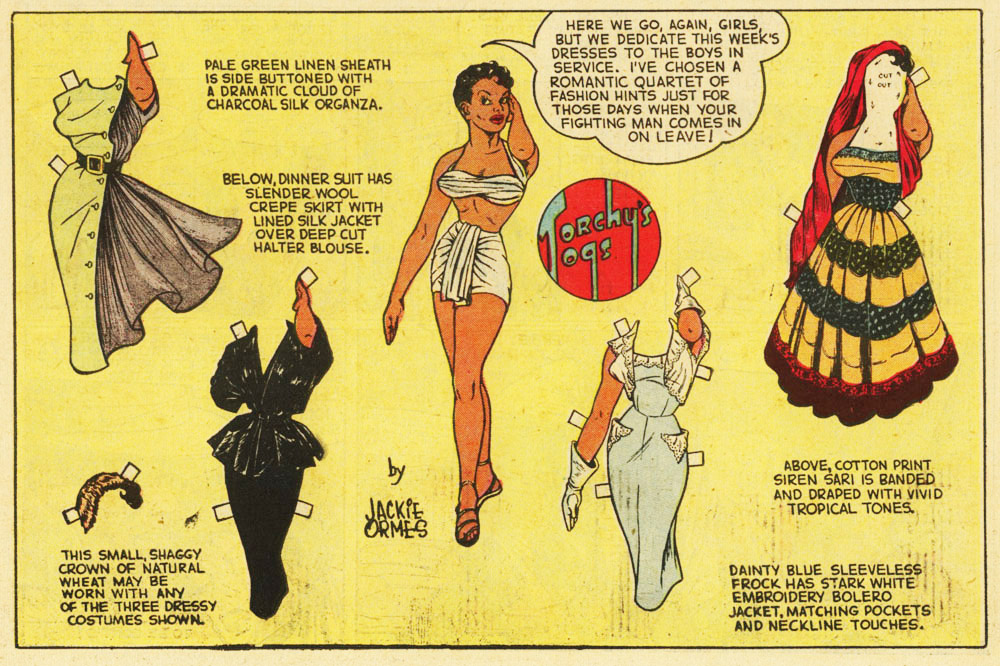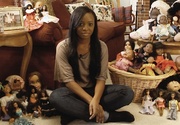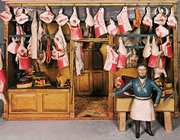In the cookie-cutter conservative era of the 1950s, even good, wholesome girls were undressing Elvis, and not just in their minds. Young women across America indulged their fashion-fueled fantasies with little paper playmates of the rock-‘n’-roll king, the latest subject from a thriving paper-doll industry that knew its audience well.
“Young women identified with her independence, even if they could not yet claim it for themselves.”
During the mid-20th century, the popularity of paper dolls peaked and production boomed like never before. By then, the medium was well-established as a cheap way for young people to make believe: You could be Martha Washington, carefully selecting a regal wardrobe, or a rebellious teen-queen cruising around with famous rock idols. But these simple-seeming toys have a complicated past.
Modern paper dolls are actually descendants of the 18th-century jumping-jack, or “pantin,” as it was known in France. These jointed paper figures were used by adults as puppets to satirize the noble classes, and didn’t come with removable outfits. By the mid-1700s, paper dolls with changeable wardrobes began appearing in fashion centers like London, Paris, and Berlin, generally as advertisements to showcase the latest styles. The big breakthrough came in 1796, with the invention of lithography. This new printing method utilized flat limestone plates marked with oil or wax, and allowed publishers to create larger runs of exquisitely detailed, hand-colored paper figures.

Top: A group of dolls found in an old stationery box, courtesy Tracy’s Toys. Above: A tongue-in-cheek depiction of Elvis in “Pageant Magazine,” circa 1957. Images courtesy Linda Ocasio.
Featuring popular characters from books, comic strips, and eventually films, as well as real-life celebrities, paper dolls suddenly captured the imagination of children everywhere. For the first time, kids of all economic levels could play with their pop-culture idols, and the paper-doll industry took note, focusing on products that would market well to young ones.
The earliest paper doll made explicitly for children was S&J Fuller’s “Little Fanny,” produced in London in 1810, followed by the Boston-based J. Belcher’s “The History and Adventures of Little Henry” in 1812. These paper characters accompanied small toy books, or “chapbooks,” and were designed to act out various scenes as their narratives unfolded. Celebrity paper dolls joined the industry in the 1830s, beginning with those modeled after Swedish ballet star Marie Taglioni and her elaborate stage outfits.

An early Marie Taglioni doll with her famous fairy outfit from “La Sylphide.” Photo courtesy of The United Federation of Doll Clubs, Inc. Doll courtesy Laurie McGill.
Paper-doll and ephemera collector Linda Ocasio, creator of the blog The Paper Collector, explains that chapbooks were designed to teach kids certain lessons, with detailed outfits serving to reinforce each morality tale. “These early paper dolls were included with stories about a child going through some challenges and making the right choices, with different scenes to show that progression,” says Ocasio.
In “Little Fanny,” the title character is a vain little girl who sneaks off to the park with her maid, only to be robbed of all her possessions, even her clothes. Aimed at upper-class children, the book traces Fanny’s journey as she works her way out of poverty and returns to her mother, changing outfits with each chapter. By the end of the book, Fanny has turned her attention to the more productive pastime of reading, rather than idly playing with toys.

The “Little Fanny” book and paper dolls series. Via Paper Thin Personas.
While some 19th-century dolls were sold as complete sets like these, others were designed as promotional items. In 1840, Godey’s Lady Book became one of the first magazines to include paper dolls in its pages, though many newspapers and journals soon followed. Other advertising paper dolls were given away for free, as a type of trade card, or inserted into a product’s packaging as a premium to enhance sales.
“You might have to collect a label and then send away for a doll,” says Ocasio, “or sometimes it might have been stuck in the actual package, the way you got a toy in the Cracker Jack box.” Companies like Pillsbury Flour, Hood’s Sarsaparilla, Aunt Jemima’s Pancake Flour, and McLaughlin’s XXXX Brand Coffee included paper dolls with their products for decades, banking on the purchasing power of whiny children. Ideally, if they wanted the entire family of characters made for a certain brand, kids would urge their parents to keep buying the company’s products.
In a time before photography was widely available, colorful illustrations offered an intoxicating new form of entertainment. “The anthropomorphic dolls from the mid-19th century are not like a comic book Mickey Mouse,” says Ocasio. “They’re these beautifully illustrated pigs or cows dressed up as human beings.” The fact that such incredible detail was lavished on disposable toys is often surprising to modern viewers, but during the 19th century, this sort of romanticized artwork was all the rage.
The most successful paper-doll enterprise, the McLoughlin Brothers company, got its start in 1828 with ornate, woodblock-printed paper dolls. McLoughlin would eventually become the largest paper-doll manufacturer in the world, famous for its creations with alliterative names like Dottie Dimple, Lottie Love, and Jenny June. Besides selling its own sets, McLoughlin also supplied other brands with promotional dolls and licensed its designs to newspapers and magazines that hoped to boost circulation.
The company eventually diversified to include all manner of printed materials, from board games to picture books, each utilizing its signature style of bright, artist-rendered imagery. In addition to popularizing new color-printing techniques like chromolithography, McLoughlin’s success also cemented the trend for tabbed paper-doll clothing. The simple, yet ingenious, use of paper tabs replaced sealing wax to hold outfits onto their matching dolls. Eventually, McLoughlin Brothers was sold to Milton Bradley.
Meanwhile in Europe, Raphael Tuck and Sons cornered the high-end paper-doll market. Founded in 1866, Tuck adopted a thicker cardboard material to achieve higher-quality printing, securing the Queen’s “Royal Warrant of Appointment” in 1893. Tuck became most famous for its trendy postcard designs, though the company’s series of pre-cut “Dressing Dolls,” like the Bridal Party from the 1890s, are stunning pieces of paper ephemera.
Advancements in printing technology also allowed paper dolls to be more individualized than standard porcelain or plastic dolls. “You can get a lot more detail in an illustration than you can in a mold that’s made to be mass-produced,” says Jenny Taliadoros, who manages the paper-doll publishing company Paper Studio Press and has the paper-doll gene in her family: Taliadoros’s grandmother was a major collector, and her mother was an artist who created her own paper-doll series.
Taliadoros believes the intricacy of paper dolls is due in part to their link to fashion illustration, as many paper-doll artists also worked for the garment industry. “A lot of our current artists were fashion illustrators in the 1950s, ’60s, or ’70s. And a couple of them were really big names, like Jim Howard, who was considered one of the very top illustrators in the U.S., or David Wolfe, who was a top illustrator in Europe.” Their beautiful drawings for designers and departments stores translated well to paper dolls, especially since many sets focused on the importance of expressive clothing.

A series of homemade catalog dolls from the 1940s. Courtesy Linda Ocasio.
For many collectors, artistry isn’t the only draw—it’s the ghost of a paper doll’s previous owner that makes the vintage objects so appealing. Whether from 20 or 200 years ago, the personalities of these little girls and boys are particularly strong in handmade paper dolls, often constructed by children whose parents couldn’t afford to purchase toys.

A factory-printed doll head on a handmade body. Courtesy Linda Ocasio.
A common variety of handmade paper dolls are “catalog dolls,” made from discarded department-store catalogs, like the ubiquitous tomes from Sears, Roebuck & Co. Children would carefully cut around a model, and then find various items of clothing that best aligned with the illustrated or photographed model’s limbs.
Other kids traced images from books, or created drawings entirely from their own imaginations. “The best is when you find a paper doll where the child made her own clothes for it, or actually created her own doll,” says Ocasio. “Some of those handmade dolls are so exquisitely done, they’re in the realm of folk art.”
The oldest dolls in Ocasio’s collection are from a McLoughlin “Tom Thumb” series dating to the 1870s, and were found with a handwritten letter gifting the set from one girl to another. “It’s the one I cherish the most,” says Ocasio, who received the dolls from her mother-in-law after she discovered them in a Florida antiques shop. “Although they’re not in the best shape,” says Ocasio, “the history and letter that goes along with them is really intriguing.” What became of the young women that shared these dolls?
Though a specific doll’s provenance is often difficult to trace, the historical moments they document are generally clear. While much of the paper doll’s political power was lost after the original pantin puppets were translated to children’s toys in the early 19th century, they continued to reflect episodes of social change, particularly involving women and their growing public presence.
Take Fluffy Ruffles, for example, a character originating in a 1906 cartoon for the New York Herald. Fluffy was an independent, career-minded woman struggling to make it in a man’s world.

This 1907 Fluffy Ruffles set shows the character’s distinctive professional attire. Courtesy Linda Ocasio.
“Suddenly, you had more women entering the workforce as secretaries, or starting to work outside the home,” explains Ocasio. “That led to a lot of discomfort in the predominantly male workplace, so this cartoon character was almost a safety valve for those fears. Whatever job she got, she lost it immediately because she was so gorgeous and charming that men interfered with her doing her work. Of course, the only reason she needed a job was because her inheritance fell through, so that put her in a different class altogether.”
Despite her silly name, Fluffy became such an icon that real women began imitating her: Macy’s created a clothing line named after her, and the Herald held a contest to find women that embodied her personality. “It’s really interesting how that particular comic strip and paper doll captured the imagination of young women who identified with her independence, even if they could not yet claim it for themselves,” says Ocasio. Eventually, characters like Fluffy Ruffles were supplanted by stronger female role models, including the glamorous reporter Brenda Starr, whose comic strip debuted in 1940.

A Brenda Starr doll from the 1940s depicts the saucy redhead in her office.
Since the heyday of paper dolls preceded the civil-rights movement of the 1960s, non-white characters are few and far between, and those that do depict other ethnicities were often derogatory in some way. Yet, the lead character in Jackie Ormes’s “Torchy” series defied the trend.
As the first successful African-American female cartoonist, Ormes created many comics starring black characters, like her “Torchy in Heartbeats” strip, which began in 1950. The series followed Torchy’s globe-trotting adventures as she chased after romance and generally led a life of intrigue, though Ormes also included difficult themes of racial and social injustice. The comic culminated in 1954 with Torchy and her boyfriend combating environmental discrimination in a fictional American town called Southville.
Ormes’s strip also regularly included a paper-doll set called “Torchy Togs,” showcasing the lead character’s stylish, modern wardrobe. Eventually, Ormes would go on to design the Patty-Jo doll, the first African-American doll aimed at a newly prospering middle class.
After the rise of Barbie in the 1960s, the paper-doll market shrunk drastically, despite its attempts to keep up with pop culture by selling sets of the Monkees or The Beatles. Though the world of toys has continued to change drastically, as visible in the many high-tech gadgets aimed at children, the simple pleasures of paper dolls haven’t been entirely forgotten.
Taliadoros knows there’s still an audience drawn to the artistry of printed paper, though ironically, today it’s made up of more adults than kids. “I’ve had so many people call up, in tears, telling me about their childhood memories and how happy they are to be connected again with something they love so much,” says Taliadoros. “It’s a really happy place to be.”
Paper Dolls Through the Ages
(Special thanks to Linda Ocasio, Jenny Taliadoros, Tracy’s Toys, and The United Federation of Doll Clubs, Inc.)
























 When Postcards Were the Social Network
When Postcards Were the Social Network
 Black Is Beautiful: Why Black Dolls Matter
Black Is Beautiful: Why Black Dolls Matter When Postcards Were the Social Network
When Postcards Were the Social Network Baby's First Butcher Shop, Circa 1900
Baby's First Butcher Shop, Circa 1900 Paper DollsA paper doll is simply a flat drawing or print of a human or animal figure,…
Paper DollsA paper doll is simply a flat drawing or print of a human or animal figure,… Mari Tepper: Laying it on the Line
Mari Tepper: Laying it on the Line Nice Ice: Valerie Hammond on the Genteel Charm of Vintage Canadian Costume Jewelry
Nice Ice: Valerie Hammond on the Genteel Charm of Vintage Canadian Costume Jewelry How Jim Heimann Got Crazy for California Architecture
How Jim Heimann Got Crazy for California Architecture Modernist Man: Jock Peters May Be the Most Influential Architect You've Never Heard Of
Modernist Man: Jock Peters May Be the Most Influential Architect You've Never Heard Of Meet Cute: Were Kokeshi Dolls the Models for Hello Kitty, Pokemon, and Be@rbrick?
Meet Cute: Were Kokeshi Dolls the Models for Hello Kitty, Pokemon, and Be@rbrick? When the King of Comedy Posters Set His Surreal Sights on the World of Rock 'n' Roll
When the King of Comedy Posters Set His Surreal Sights on the World of Rock 'n' Roll How One Artist Makes New Art From Old Coloring Books and Found Photos
How One Artist Makes New Art From Old Coloring Books and Found Photos Say Cheese! How Bad Photography Has Changed Our Definition of Good Pictures
Say Cheese! How Bad Photography Has Changed Our Definition of Good Pictures Middle Earthenware: One Family's Quest to Reclaim Its Place in British Pottery History
Middle Earthenware: One Family's Quest to Reclaim Its Place in British Pottery History Fancy Fowl: How an Evil Sea Captain and a Beloved Queen Made the World Crave KFC
Fancy Fowl: How an Evil Sea Captain and a Beloved Queen Made the World Crave KFC
Readers are referred to “Costumed by Hand: Yesteryear’s Best-Dressed Paper Dolls” by Francine Kirsch which ran in the Spring/Summer 2007 issue of Folk Art Magazine, the publication of the American Museum of Folk Art. In addition to the essay by Ms. Kirsch, the ten page article was accompanied with numerous illustrations of HANDMADE paper dolls, often made by little girls during the depression out of need, frequently giving paper a second or third life. Many handmade and homemade paper dolls have an innocent charm and primitive quality which outshines the commercial products (which are often brands)…and they are also many times as elaborate as the manufactured dolls. Handmade antique paper dolls are far more difficult to find today than the commercial ones, but quite rewarding.
Jim Linderman
Dull Tool Dim Bulb the Blog
I had a 3′ tall Jackie Kennedy paper doll in the 1960’s!
What a fantastic site which I’ll send forward to the friends.
Best regards from Denmark
My sister and I waited every month for my mom’s McCall’s magazine to see if there was a Betsy McCall in the back!
Divine, Esther, Liz, Elvis, Brenda Starr and those dolls from the BOSTON HERALD were a joy to behold!
thanks Vetraio! :)
You mention Barbie in passing, Hunter, but did you know that one of the inspirations for Barbie dolls was the fact that Ruth Handler, (wife of the founder of Mattel, Elliot Handler, and acknowledged brainchild behind Barbie) watched her daughter Barbara play with paper dolls for hours? She knew your girls were fascinated with fashion, and wanted to create a real doll to model those spectacular fashions of the fifties.
I did not know that Stef! Very interesting – we might have to do an article just about Barbie someday :)
Thanks for the memory !! :o)
How much did paper dolls cost in the 1950s?
Interesting article! Do you know anything about Parker Brothers Improved Paper Doll Outfit? A boxed set with two jointed dolls, one cutout doll and craft supplies to make dresses from their suggested patterns. Crepe paper and more exotic printed papers were included in the box. Copyright date is 1917.
Thanks for any information you can supply!
I remember getting the Bobbsy Twins paper dolls and my favorite was my Shirley Temple paper dolls. My stepsisters and I would make our dresses and color them for the paperdolls. I loved them.
I loved paper dolls , congratulations for post .
Can I get a printed copy of this wonderful article? I would love to present it at my doll club meeting.
I have a historical cut out book, paper dolls…. have tried to find info. about but no luck..
Little Friends From History Mariel Wilhoite 1936 Rand McNally
Has Geo./Martha Washington, Abe Lincoln, among others…..oversized book…
I have seen other books with her illustrations and have searched the net…
Greetings – I have inherited a box of vintage, uncut, excellent condition paper dolls from my mother. I am looking for a place (besides the trash!) or a person to whom I could give them. Do you have any recommendations? I also have an extensive doll collection that was hers…..
Thank you for your time!
I would love them!